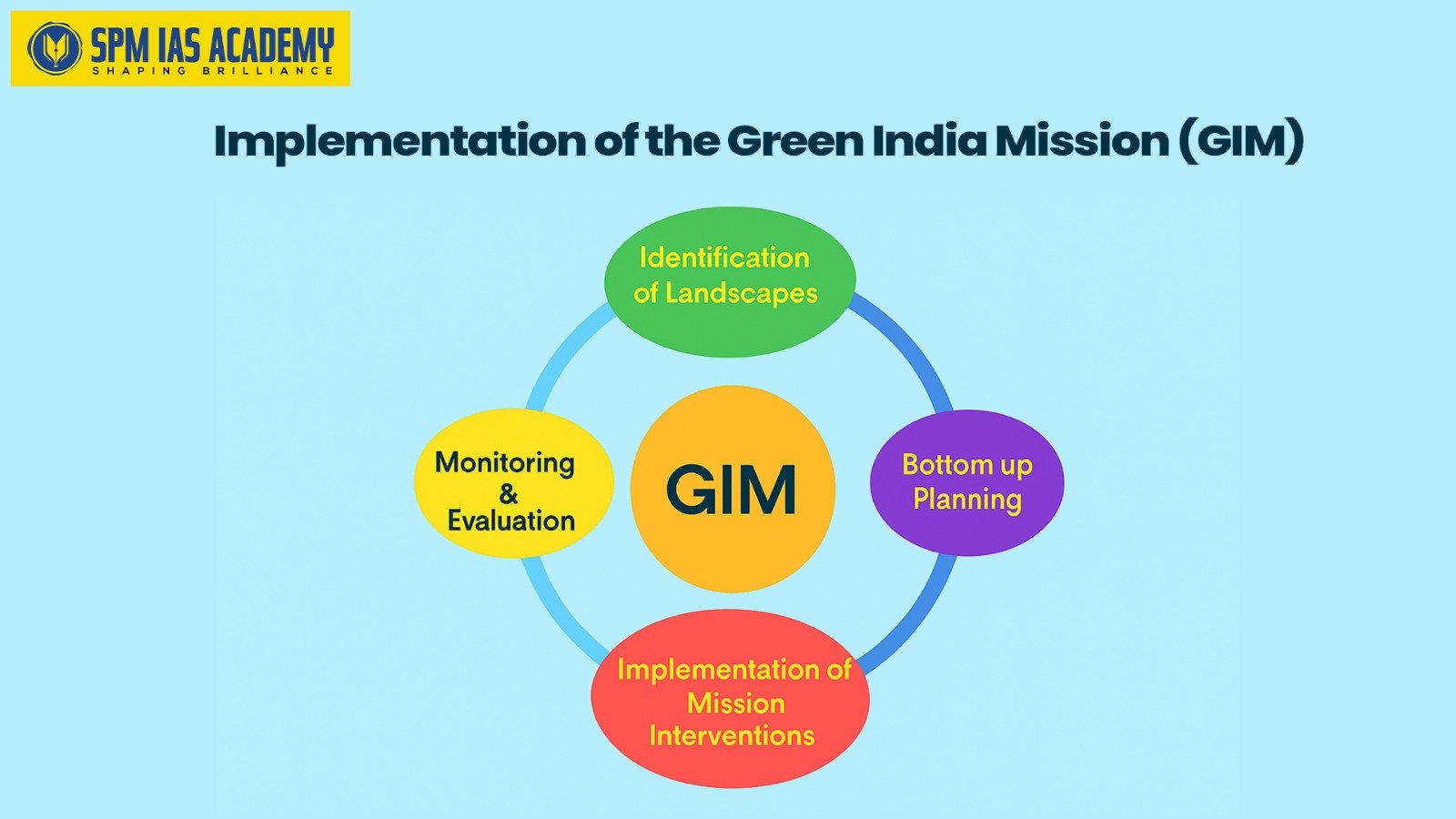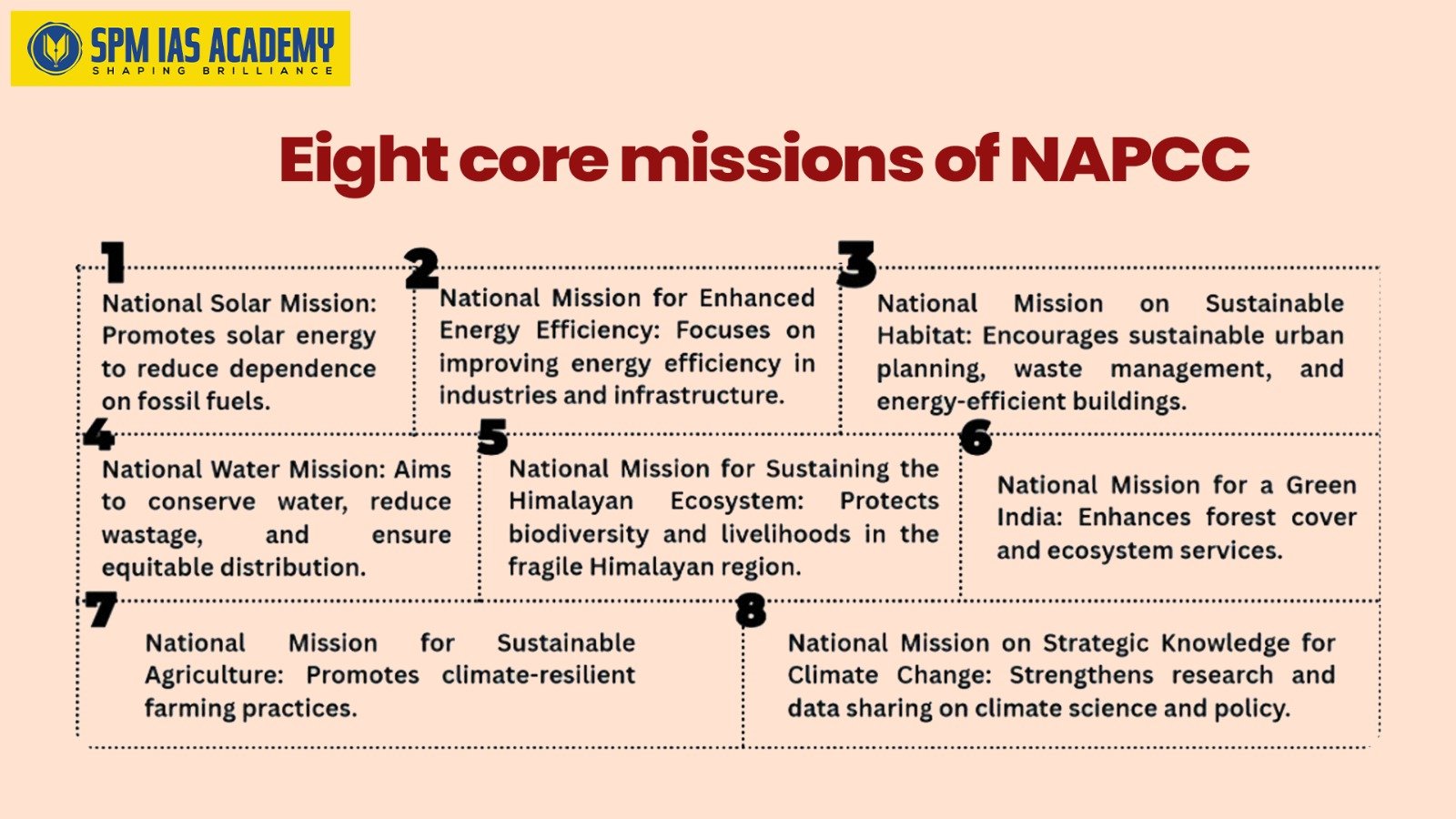Current Green India Mission: The overall budget for the National Mission for Green India has been cut by 6.7 percent as detailed in the Union Budget 2021. GIM, as a component of the National Mission, has received an allocation of Rs 250 crore (which is 11 crore less than in 2020).
Introduction
The Green India Mission (GIM) was launched in February 2014. It is an important initiative under the National Action Plan on Climate Change (NAPCC). The objectives of the Green India Mission reflect India’s commitment to combating climate change. In addition, it also aims to safeguard its biodiversity and livelihoods.
The National Mission for a Green India is important for UPSC exam preparation. Aspirants must understand its key features for effective climate change adaptation and mitigation in India.
In this article, we will look into the Green India Mission, its goals, and benefits. In addition, we will also look into the GIM implementation, which will be helpful in your UPSC exam preparation.
What is the Green India Mission (GIM)?
The Green India Mission is an organized project with defined objectives, timelines, and measurable results. Furthermore, it has a “mission mode” to increase forest and tree cover by a total of 5 million hectares. The National Mission for a Green India adopts a sustainable approach to greening and increasing forest cover. It also focuses on carbon sequestration and various ecosystem services, including biodiversity, water, and biomass. GIM strategy also works to improve the livelihoods of households that live on the periphery of the project areas.
1. Background of Green India Mission
The Green India Mission is a national venture initiated by the Government of India in 2014. It was implemented under the National Action Plan on Climate Change. The benefits of the GIM include seeking to combat climate change and environmental degradation. It also focuses on afforestation and sustainable forest management throughout the country. The Green India Mission is a comprehensive program aimed at increasing forest and tree cover across various landscapes, including urban areas, to enhance ecosystem service benefits from nature.
2. The Alignment of Climate and Forest Policy
The Green India Mission was initiated in 2014 as one of the eight core missions of the National Action Plan on Climate Change (NAPCC). It aims to address any challenges related to climate change through afforestation and the restoration of ecosystems. There was a significant enhancement in improving biodiversity and increasing forest-based communities’ resilience in the GIM program, as opposed to previous conventional forestry programs.

3. Initiating Goals
The GIM strategy included creating 5 million hectares of new forest and tree cover, and enhancing the quality of forest cover in a further 5 million hectares. Further, the benefits of GIM include the enhancement of the ecosystem services that are important for carbon sequestration, water regulation, and soil fertility. The Green India Mission had a strong emphasis on local people’s involvement through collective management of the forest committees, self-help groups, and decentralisation of planning.
3. Success and Failures of Green India Mission
In reported statistics from 2014 to 2020, the Green India Mission successfully advanced afforestation across various states, with a total of 11.22 million hectares showing plantations. However, results have been equivocal. The reports mentioned poor forest growth, a lack of transparency in funding, and a shortage of funds. In some situations, there were ecological mismatches due to a lack of a regional basis approach. The changing climate goals in India, along with the Paris Agreement, make it necessary to update and improve this vision and mission approach.
Goals and Objectives of Green India Mission
The Green India Mission aims to enhance forest and tree cover while improving the quality of various forest ecosystems. The mission’s target includes a growth of forest cover by 5 million hectares (mha) and an increase in quality across another 5 mha of forest or non-forest lands, with specific focus areas including grasslands, dense forests, wetlands, and more.
The objectives of the Green India Mission include the following:
1. Improvement of Forest Quality
Revitalization of moderately dense forests (1.5 million hectares).
Ecological restoration of open forests (3 million hectares).
Revival of grasslands (0.4 million hectares) and wetlands (0.10 million hectares).
2. Ecological Restoration
Restoration efforts will target shifting cultivation areas, mangroves, scrublands, ravines, cold deserts, and abandoned mining sites, totaling 1.8 million hectares.
3. Urban and Agroforestry Development
Coupled with the goal of an increase in forest cover in urban areas and their outskirts (0.20 million hectares), it focuses on sustainable urban development.
In addition, the Growth of forest and tree cover on marginal agricultural lands, fallows, and other non-forest areas under agroforestry (3 million hectares).
4. Livelihood Enhancement
The mission aims to boost forest-based livelihood income for approximately 3 million households living in and around forest areas.
5. Carbon Sequestration Goals
An ambitious target to increase carbon dioxide sequestration by 50 to 60 million tonnes by 2020.
By focusing on these objectives, the Green India Mission seeks to improve the overall quality of forest cover and ecosystem services while also promoting sustainable livelihoods and environmental restoration.
Implementation of the Green India Mission
The Green India Mission is an important effort to boost forest cover and combat climate change. It emphasizes community involvement in forest management and focuses on afforestation, reforestation, and sustainable land use to create a greener, more resilient India.
Below are some of the implementations of the National Mission for a Green India:
1. The nation operates through the Ministry of Environment and Forests for implementation nationally, including the State Forest Development Agency at the state level to guide the mission.
2. The State Forest Development Agency will conduct implementation at the district level.
Gram sabha and other committees are key institutions for planning and implementation at the village level.
3. In urban areas, committees at the ward level, such as Residents Welfare Associations (RWA), will assist in planning and implementation.
4. The GIM strategy is related to the respective municipality or municipal corporations and is part of the overall mission.
5. One of the objectives of Green India Mission is to train 1 lakh skilled local community youth who would help support Community-Based Forest Conservation. Further, they can also be the linked between the community and implementing agencies like the forest department.

1. Budget of the Green India Mission
Green India Mission Cost as published by the Ministry of Environment, Forest & Climate Change (latest) :
| Convergence Details | Amount (Rs crores) |
| Green India Mission | Rs 2000 |
| Compensatory Afforestation Fund Management & Planning Authority (CAMPA) | Rs 6,000 |
| Mahatma Gandhi National Rural Employment Guarantee Scheme (MNREGS) | Rs 4,000 |
| 13th Finance Commission Grants | Rs 400 |
| National Afforestation Programme | Rs 600 |
Click here to see the details of the Green India Mission by the government.
2. Difference Between Green India Mission and Other NAPCC Missions
The Green India Mission (GIM) is part of the National Action Plan on Climate Change (NAPCC). It focuses specifically on forest-based mitigation and adaptation strategies with community involvement. GIM directly addresses climate change through actions that protect, restore, and enhance forest and tree cover.
Further, the GIM includes a 1-year preparatory phase, which was not present in the other missions of NAPCC.
| Feature | Green India Mission (GIM) | Other NAPCC Missions |
|---|---|---|
| Primary Objective | Mitigation and adaptation through forestry. Aims to protect, restore, and enhance India’s forest and tree cover to combat climate change. | Sector-specific climate action. Focus on key sectors like solar energy, water, energy efficiency, or sustainable agriculture. |
| Scope of Action | Broad and holistic. Addresses a range of ecosystem services beyond just carbon sequestration, including biodiversity, water resources, and livelihood security for forest-dependent communities. | Focused and specialized. Concentrates on a particular sector to achieve specific targets, such as increasing solar power capacity or improving water use efficiency. |
| Implementation Strategy | Community-centric and decentralized. Employs a decentralized approach with a strong emphasis on community participation through Gram Sabhas (village councils) and Forest Development Agencies. | Centralized and technology-driven. Often relies on large-scale, top-down implementation, technological advancements, and financial incentives to achieve mission goals. |
| Key Focus Areas | Ecosystem restoration. Aims to improve the quality of forests, restore grasslands and wetlands, and promote agroforestry. | Technological solutions and policy. Examples include the National Solar Mission’s focus on renewable energy technologies or the National Mission for Enhanced Energy Efficiency’s emphasis on market-based mechanisms and policy reforms. |
Features of the Green Indian Mission
The Green India Mission has several important components that make it different from earlier forestation programmes in the country. Some of the primary features include the following:
1. The mission adopts a holistic, landscape-based approach towards forest management. In addition, it sees the interconnected nature of different land-use systems and their contributions to the functioning of ecosystems.
2. The Green India Mission emphasizes the active participation of local communities, particularly vulnerable groups. It includes their participation in the planning, implementation, and monitoring of afforestation and forest management operations.
3. The mission covers various programmes. It works on the restoration of degraded forests and the expansion of tree cover in urban and peri-urban areas. It also looks after the management of agro-forestry practices and the establishment of bamboo forests.
4. The National Mission for a Green India intends to develop the capacity of various governmental agencies. It also covers the local institutions, focusing on natural resource management and conservation efforts.
Significance of the Green India Mission
The Green India Mission is highly relevant in light of India’s environmental challenges and issues related to climate change. Deforestation, land degradation, and the reduction of biodiversity have become serious issues in our country. It leads to important implications for many livelihoods, especially in rural areas. The objectives of the Green India Mission of restore and rehabilitate forest cover and tree density. It also expects to yield wide-ranging benefits, for example:
- Mitigation of climate change impacts through carbon dioxide sequestration and local and regional climate regulation.
- Improving ecosystem and community resilience to climate change impacts, e.g., extreme weather events, droughts.
- Improving ecosystem services, e.g., water recharge, soil conservation, biodiversity protection, etc.
- Creating livelihood and income opportunities for communities, especially those relying on forest and tree resources.
- Improving environmental quality in the urban and rural landscape and the amenity value of the landscape.
Challenges Faced by the Green India Mission
The Green India Mission faces many challenges. Some of the challenges faced by the National Mission for a Green India are:
- Finding suitable land for afforestation and forest restoration is a significant challenge in crowded areas.
- The mission requires considerable and continuing financial resources to meet its objectives. However, in some cases, the funding has been inconsistent.
- Another key point is to achieve effective coordination with other government departments, local communities, and other stakeholders. It is essential to the successful implementation of the mission, and can be challenging in practice.
- Monitoring and evaluation frameworks are necessary to assess the progress and impact of the mission’s activities. However, developing and implementing these frameworks can be challenging.
- The mission’s success relies on restored and enhanced forests that will cope with the consequences of climate change. It will also resist higher temperatures, alterations in precipitation, and other climate conditions. It will also impact on the changes in the spread of pests and diseases.
Conclusion
The updated Green India Mission addresses rising temperatures and environmental challenges in India. Further, it integrates scientific and traditional knowledge while aligning with global climate targets. GIM emphasizes sustainability, community participation, and biodiversity restoration, aiming for a climate-resilient and environmentally safe India.
Frequently Asked Questions
A: This index evaluates the green economy performance of 130 countries across four dimensions. These dimensions are leadership & climate change, efficiency sectors, markets & investment, and the environment.
A: The Green India Mission seeks to improve forest quality and ecosystem services. It targets 5 million hectares of degraded areas and increases urban-peripheral forest cover by 0.20 million hectares.
A: The Mission aims to increase forest cover on 10 million hectares. It also aims to enhance ecosystem services like biodiversity and carbon sequestration.
A: The Green India mission was launched in 2014 as part of India’s National Action Plan on Climate Change. The initiative aims to increase forest cover on 5 million hectares and improve another 5 million hectares. Significantly, from 2015-16 to 2020-21, it facilitated afforestation on 11.22 million hectares.
A: The vision aims to enhance forest cover on 10 million hectares. Moreover, it achieved afforestation on 11.22 million hectares from 2015-21.












